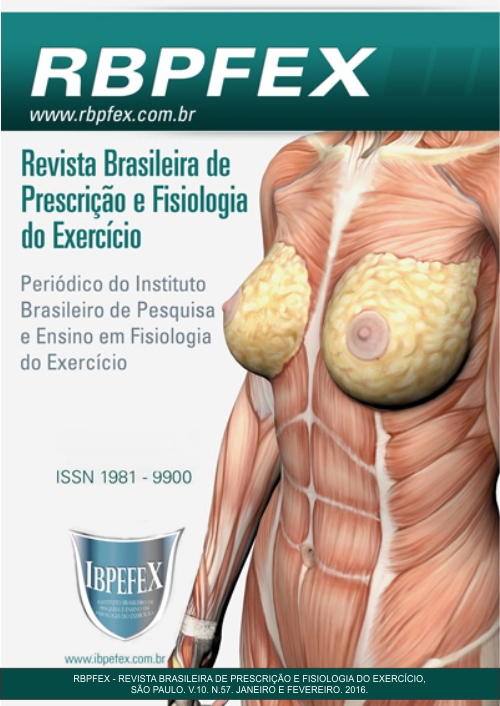Pharmacotherapy impact of urinary no increase in body temperature in paratleta: case repor
Abstract
The research aimed to the case report of the impact of drug therapy for urinary incontinence in increased body temperature in paratleta. Interview was conducted with the patient and recording of body temperature measurements (axillary), heart rate (carotid pulse) and blood pressure before, during and immediately after physical activity, namely weight. The study is in accordance with Resolution No. 499/12 of the CNS / MS. The results show a higher body temperature during sports practice. At the end of the training observed increase of more than 3 ° C; increased heart rate and blood pressure. Stands out initial maintenance diastolic blood pressure followed by reduction. You can assume that result from the reduction of sweating triggered by the use of medication and / or used supplementation. Note that oxybutynin prevents sweating, causing the body temperature remains changed after exercise for longer than normal. The management of neurogenic bladder should include evaluation on the athlete's performance. Moreover, the concern should not be focused only on the control of incontinence, but as the pharmacological and non-pharmacological measures may interfere with lifestyle and athletic performance, an interdisciplinary approach.
References
-Abrams, P.; Anderson, K.E.; Birder, L.; Brubaker, L.; Cardozo, L.; Chapple, C. e colaboradores. Fourth International Consultation on Incontinence Recommendations of The International Scientific Committee: Evaluation and treatment of Urinary Incontinence, Pelvic Organ Prolapse, and fecal Incontinence. Neurourol Urodynamics. Vol. 29. p. 213-240. 2010.
-Araújo, A. P. S.; Menóia, E. Atividade Lipolítica Durante a Prática de Atividade Física: Enfoque sobre o consumo de oxigênio, produção de ATP e o estímulo neuro-humoral. Revista Saúde e Pesquisa. Vol. 1. Núm. 2. p. 177-184. 2008.
-Becker, H.D.; Stenzel, A.; Wallwiener, D.; Zittel, T.T. Urinary and Fecal Incontinence. Springer. Berlin. 2005. 498 p.
-Caromano, F. A.; Themudo Filho, M. R. F.; Candeloro, J. M. Efeitos fisiológicos da imersão e do exercício na água. Rev. Fisioterapia Brasil. Vol. 4. Núm. 1. p. 60-63. 2003.
-Francis, K. Physiology and Management of Bladder and Bowel Continence following Spinal CordInjury. Ostomy Wound Management. Vol. 53. Núm. 12. p. 18-27. 2007.
-Guirro, E.; Guirro, R.; Fisioterapia dermato-funcional: fundamentos, recursos, patologia. 3ªedição. Manole. 2006.
-Kirshblum, S.C.; Burns, S.P.; Biering-Sorensen, F.; Donovan, W.; Graves De, J.H.A.A.; e colaboradores. International Standards for Neurological classification of spinal cord injury (revised 2010). The Journal of Spinal Cord Medicine. Vol. 34. Núm. 6. p. 535-46. 2011.
-Leite, P. F. Fisiologia do Exercício: Ergometria e condicionamento físico, cardiologia desportiva. 4ª edição. Robe Editorial. 2000.
-Lyra, R. M.; e colaboradores. Diretrizes para a prevenção, diagnóstico e tratamento da hiperidrose compensatória. J. bras. pneumol. Vol. 34. Núm. 11. p. 967-977. 2008.
-Mcardle, W. D.; Katch, F. I.; Katch, V. L. Fisiologia do Exercício: Energia, Nutrição e Desempenho Humano.4ª edição. Guanabara Koogan. 1998.
-Powers, S. K.; Howley, E. T. Fisiologia do Exercício: Teoria e Aplicação ao Condicionamento e ao Desempenho. 3ª edição. Manole. 2000.
-Rodrigues, S.F. A eficácia da fisioterapia no período pré-operatório de pacientes obesos mórbidos com indicação à cirurgia bariátrica através da pao2. TCC de graduação em fisioterapia. Universidade Estadual do Oeste do Paraná. Cascavel. 2004.
-Sociedade Brasileira de Urologia. Projeto Diretrizes. Trauma raquimedular: Conduta urológica clínica e farmacológica. 2006.
-Wyndale J.J.; Bruschini H.; Madersbacher H.; Moore K.; Pontari M.; Wein A. Neurological patients need evidence-based urological care. Neurourol and Urodynamics. Vol. 29. p. 662-669. 2010.
Authors who publish in this journal agree to the following terms:
- Authors retain the copyright and grant the journal the right of first publication, with work simultaneously licensed under the Creative Commons Attribution License BY-NC which allows the sharing of the work with acknowledgment of the authorship of the work and initial publication in this journal.
- Authors are authorized to enter into additional contracts separately for non-exclusive distribution of the version of the work published in this journal (eg, publishing in institutional repository or book chapter), with acknowledgment of authorship and initial publication in this journal.
- Authors are allowed and encouraged to post and distribute their work online (eg, in institutional repositories or on their personal page) at any point before or during the editorial process, as this can bring about productive change as well as increase impact and impact. citation of published work (See The Effect of Free Access).






